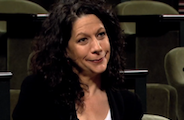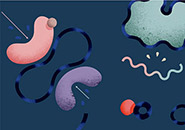
Scientific Discipline
Biophysics, Structural Biology
Host Institution
Massachusetts Institute of Technology
Current Position
Dr. Drennan is also a professor of chemistry and biology and an HHMI investigator at the Massachusetts Institute of Technology.
Current Research
Improving Teaching and Mentoring in Chemistry Nationwide
Research
Biography
Catherine Drennan understands why some Massachusetts Institute of Technology (MIT) students may sign up for her freshman chemistry class grudgingly and only because it is required. After all, when she began her undergraduate studies at Vassar College, she thought chemistry had no relevance to her two intended majors: drama and biopsychology. "I wasn't even sure what biopsychology was, but it sounded good," says Drennan, now associate professor of chemistry. "When they insisted I had to take chemistry, I thought it was so unfair."
But she took the required course and fell in love—hard—with the beauty of chemistry. She grew fascinated with the molecular details underlying biological systems and wound up majoring in chemistry. "I'll admit that the basic principles are not that exciting in and of themselves," she says, "but chemistry is at the heart of biology."
After college, Drennan spent two years teaching high school science and drama at a Quaker boarding school in the Midwest that doubled as a working hog farm. But she realized her passion to know how things work could be satisfied only by a research career. Now Drennan's studies drill down to the structural basis of how molecules work, as exemplified in one of her recent research articles that answers a mystifying question about how nature tailors a complex antifungal agent.
Dislike or fear of chemistry, especially by biology students, is a major problem that will have an impact on the future of biological science, she says, citing a National Academy of Sciences report that too many biologists are successfully avoiding chemistry in their training. "How can we understand the complexity of macromolecular machines, for example, without employing physical chemistry?" she says. "I always thought that biology was more interesting than chemistry, but even in biology, students have to have a chemistry background to make real contributions."
In hopes of inspiring her students to take chemistry courses beyond those that are required, Drennan plans to expand the range of biological examples she already slips into her lectures for the freshman chemistry course she co-teaches. Now, she uses vitamin B12—a personal molecular favorite—so often that students start laughing every time she mentions it. "If you give me a topic, I'll find a way to use B12—acid/base, oxidative reduction," Drennan says.
She even shows a movie created by colleagues that demonstrates how the B12 enzyme has to change its shape to do its job. The molecular action on the screen is set to the tune of "Shake, Rattle, and Roll."
"That's what it's all about—chemistry in action," she says.
Drennan tells her chemistry students a story about her dad, a medical doctor who read one of her research papers and asked how folic acid could reach an apparently sealed-off part of the B12 structure in a crucial reaction. "It was a great question," she says. "It's a simple question, but it gets people thinking about, how does that work? Then they are eager to see the experiments we did to answer that question."
As an HHMI professor, Drennan plans a "boot camp" for graduate students and postdoctoral fellows in chemistry to train them in teaching and mentoring skills and to help them incorporate biological examples into their teaching. Another part of her project involves support for the MIT Undergraduate Biochemistry Association. Drennan started the group to help compensate for lack of a formal biochemistry program at MIT. So far, 86 students are interested in the group's academic advice on topics such as interdepartmental course selection and research opportunities. The group will provide networking opportunities to help students find the right study partners, an integral part of the culture at MIT and a key factor in academic success.
Articles & News
Research Papers
Selected Research Papers



